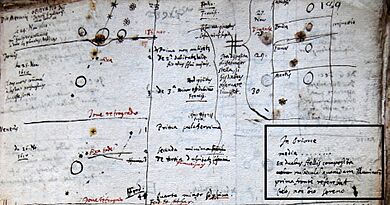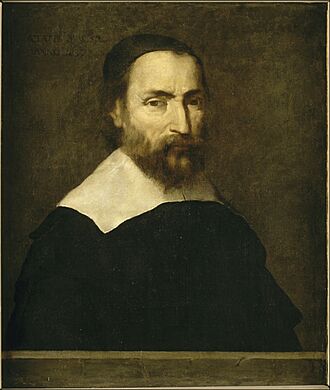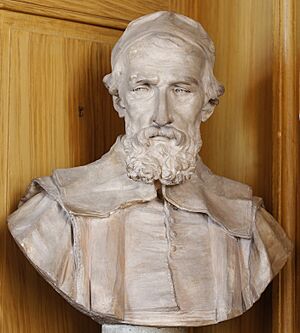Nicolas-Claude Fabri de Peiresc facts for kids
Nicolas-Claude Fabri de Peiresc (born December 1, 1580 – died June 24, 1637) was a famous French scientist and scholar. People often called him simply Peiresc. He was interested in many subjects, like astronomy (studying stars and planets) and archaeology (studying old things). Peiresc wrote many letters to other scientists and helped organize important scientific projects. He even helped figure out the exact distances between different places in Europe, around the Mediterranean Sea, and in North Africa.
Contents
Early Life and Education
Peiresc was born in Belgentier, France. His family was wealthy and his father was a judge. They moved to Belgentier to escape a serious illness called the plague. Peiresc went to school in several cities, including Aix-en-Provence and Avignon. He also studied at a special school run by the Jesuits.
While studying in Toulon, he became very interested in astronomy. He also studied law and developed a love for archaeology. To learn more, he traveled to Italy, Switzerland, and other parts of France in 1599. He finished his law studies in 1604. That same year, he took the name Peiresc from some land he inherited from his father.
After finishing school, he traveled to Paris, London, and Flanders. In 1607, he returned to Aix to become an advisor in the local government. He held this important job until 1615.
A Great Thinker and Collector
Peiresc was a very important thinker during a time when science was changing rapidly. He was sometimes called a "Prince of the Republic of Letters." This means he was a leading figure among scholars and scientists who communicated across Europe. He wrote thousands of letters to other famous people, like the artist Rubens.
Peiresc was a big supporter of science and art. He studied fossils and helped the astronomer Pierre Gassendi. He was also one of the first people in France to admire the famous painter Caravaggio. Peiresc helped other artists who painted in Caravaggio's style get work.
His house in Aix-en-Provence was like a museum! It was filled with ancient sculptures, modern paintings, old coins, books, and even gardens with unusual plants from faraway places. He collected many unique items, including a famous ancient ivory carving that is now in the Louvre Museum in Paris. He also owned over 18,000 coins and medals. Peiresc was interested in many things: he was an archaeologist, an artist, a historian, an Egyptologist, a botanist (studying plants), and a zoologist (studying animals like chameleons and crocodiles).
Peiresc the Astronomer

Peiresc was also a skilled astronomer. In 1610, he and his friend Joseph Gaultier used a telescope to observe the sky. They looked at Jupiter's moons, which had only recently been discovered. Peiresc also made detailed drawings of the Orion Nebula in 1610. This was one of the first times anyone had seen this beautiful cloud of gas and dust through a telescope.
To measure distances on Earth more accurately, Peiresc organized a special project. He arranged for people across the Mediterranean Sea to watch the same lunar eclipse (when the Earth's shadow covers the Moon) on August 28, 1635. By comparing their observations, he discovered that the Mediterranean Sea was actually 1,000 kilometers (about 620 miles) shorter than people had thought! Peiresc also wrote letters to famous scientists like Galileo.
Later Life and Legacy
Peiresc started writing a short history of Provence, his home region, but he passed away before he could finish it. It was finally published many years later in 1982. With help from Pierre Gassendi, he also began to create a map of the Moon's surface, but he died before it was completed.
Nicolas-Claude Fabri de Peiresc passed away on June 24, 1637, in Aix-en-Provence.
Works
Peiresc wrote several books and collections of letters, including:
- Histoire abrégée de Provence (A Short History of Provence)
- Lettres à Malherbe (Letters to Malherbe)
- Traitez des droits et des libertés de l'Eglise gallicane (Treatises on the Rights and Freedoms of the Gallican Church)
- Mémoires (Memoirs)
How Peiresc is Remembered

Today, a bronze statue of Peiresc stands in Aix-en-Provence, facing the cathedral. His original home in the city is no longer there.
There is a museum dedicated to his work in the village of Peyresq, near Digne-les-Bains.
Peiresc has also been honored in space! In 1935, a crater on the Moon was named Peirescius after him. And in 1993, an asteroid was named 19226 Peiresc.
See also
- List of Roman Catholic scientist-clerics



